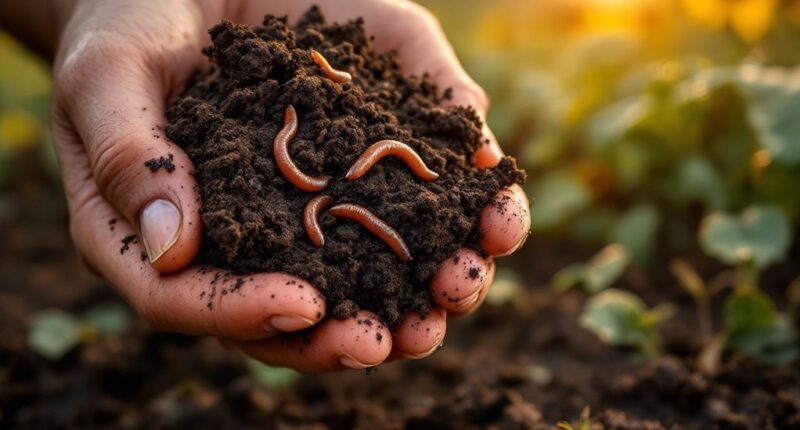Soil health forms the bedrock of sustainable agriculture, functioning as a complex, living ecosystem rather than just dirt. It blends physical structure, balanced chemistry, and biological diversity—nature’s original multitasker! Healthy soil requires minimal disturbance, constant coverage, living roots, and biodiversity to thrive. With 33% of global soils already degraded, practices like cover cropping and reduced tillage aren’t just farming techniques; they’re rescue missions for our food future. The journey to agricultural sustainability begins beneath our feet.

While many might see soil as merely dirt beneath our feet, scientists and farmers alike recognize it as a complex, living ecosystem crucial to our survival. This intricate underground world—teeming with billions of microorganisms in just a handful of earth—functions as the literal foundation for our food systems. Think of healthy soil as Earth’s most underappreciated multitasker: growing our food, filtering our water, and even helping regulate our climate.
Healthy soil isn’t just about what you can see—it’s a delicate balance of physical structure, chemical composition, and biological activity. Like a well-functioning city, it needs proper infrastructure (soil aggregates), balanced chemistry (nutrients and pH), and diverse inhabitants (microorganisms). The sweet spot for organic matter content—soil’s equivalent of a retirement savings account—typically sits between 1-5% in mineral soils, with each percentage increase dramatically improving everything from water retention to nutrient cycling. Optimal microbial decomposition occurs at temperatures between 65-75°F, creating ideal conditions for organic matter transformation.
Think of soil as Earth’s living infrastructure—where physical structure, chemistry, and biology converge to support life above and below ground.
The path to soil health follows five core principles that would make any soil microbe throw a party: keep the soil covered (like a blanket for the earth), minimize disturbance (no jackhammers in the microbial neighborhood), maximize biodiversity (the more the merrier), maintain living roots year-round (an all-season buffet for soil organisms), and integrate livestock when possible (nature’s fertilizer delivery system). Regenerative agriculture emphasizes these principles through Indigenous knowledge systems that have sustained communities for millennia.
Farmers worldwide are catching on to these principles, implementing practices like cover cropping—essentially growing plants not for harvest but for soil improvement—and reducing tillage, which is the agricultural equivalent of not constantly rearranging your living room furniture. The results speak for themselves: improved yields, better drought resilience, and reduced input costs. Sustainable farming methods also prioritize crop rotation to naturally disrupt pest cycles and restore soil nutrients without chemical inputs.
The stakes couldn’t be higher—with 33% of global soils already degraded and over 90% at risk by 2050, our relationship with soil needs serious couples therapy. The good news? Every cover crop planted, every no-till field established, and every compost pile created helps rebuild what took nature centuries to develop but humans mere decades to damage.
Healthy soil isn’t just about better farming—it’s about better futures.
Frequently Asked Questions
How Quickly Can Depleted Soil Be Regenerated?
Depleted soil regeneration isn’t an overnight miracle. Timeframes vary considerably based on soil type, climate, and management intensity.
While some improvements emerge quickly—microbial activity increases within 6-12 months with cover crops—complete regeneration requires patience.
Organic matter typically increases in 3-5 years, while structure improves in 1-3 years with reduced tillage.
Severely eroded or chemically imbalanced soils might need decades for full recovery.
Consistent regenerative practices yield progressively better results over time.
Does Soil Health Impact Nutritional Content of Crops?
Research confirms that soil health greatly impacts crop nutritional content. Healthy soils with higher organic matter consistently produce crops with enhanced levels of vitamins, minerals, and beneficial phytochemicals.
The relationship stems from improved nutrient cycling, diverse soil microbial communities, and better nutrient retention. Management practices like no-till farming, diverse crop rotations, and appropriate fertilization all influence the nutritional quality of harvested crops.
This connection highlights why soil stewardship matters beyond just yield considerations.
Can Urban Gardeners Effectively Improve Soil Health?
Urban gardeners can effectively improve soil health despite city challenges.
By building raised beds with clean soil-compost mixtures, using cover crops, and practicing minimal tillage, they overcome common urban soil issues like compaction and contamination.
Regular testing helps monitor nutrient levels and detect pollutants.
Strategic mulching, proper crop rotation, and careful pH management create thriving urban soil ecosystems.
These practices transform lifeless urban dirt into productive, living soil capable of supporting nutrient-dense crops in even the most concrete-dominated environments.
How Do Climate Zones Affect Soil Management Practices?
Climate zones fundamentally shape soil management practices.
Farmers in arid regions prioritize water conservation through drip irrigation and minimal tillage, while humid zone growers focus on drainage systems and erosion control.
Temperate climates require balanced approaches.
Organic matter management varies dramatically too—tropical soils need frequent inputs due to rapid decomposition, while cold regions see organic matter accumulate slowly.
Even tillage practices adapt to climate-specific erosion risks, with no-till methods working better in certain zones than others.
What Technology Tools Best Measure Soil Health Improvements?
To measure soil health improvements effectively, a combination of technologies offers the most thorough assessment.
NIR and MIR spectroscopy provide rapid analysis of organic matter and nutrients, while in-situ probes monitor moisture and temperature changes over time.
Remote sensing tools, particularly drone-mounted hyperspectral cameras, track large-scale changes.
For data interpretation, AI and machine learning systems transform raw measurements into actionable insights, helping farmers quantify their soil regeneration progress with unprecedented precision.









